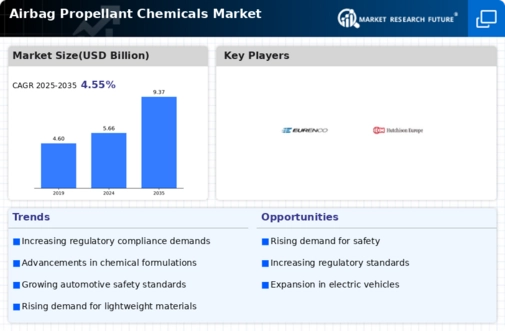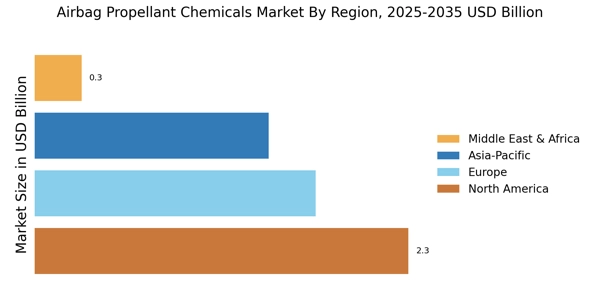Growth of Emerging Markets
The expansion of emerging markets is significantly impacting the Airbag Propellant Chemicals Market. As economies in regions such as Asia-Pacific and Latin America continue to develop, the automotive sector in these areas is experiencing rapid growth. Increased disposable income and urbanization are leading to higher vehicle ownership rates, which in turn drives the demand for safety features, including airbags. Market analysts project that the automotive industry in these regions will grow at a compound annual growth rate of over 5% in the coming years. This growth presents substantial opportunities for the Airbag Propellant Chemicals Market, as manufacturers seek to cater to the rising demand for safety-enhancing technologies.
Stringent Safety Regulations
The implementation of stringent safety regulations is a crucial driver for the Airbag Propellant Chemicals Market. Governments and regulatory bodies worldwide are enforcing rigorous standards for vehicle safety, which includes the mandatory installation of airbags. Compliance with these regulations necessitates the use of high-quality propellant chemicals, thereby boosting market demand. For instance, regulations such as the Federal Motor Vehicle Safety Standards in the United States require that all new vehicles be equipped with airbags. This regulatory landscape compels manufacturers to prioritize safety features, consequently driving the growth of the Airbag Propellant Chemicals Market as they seek to meet compliance requirements.
Increasing Vehicle Production
The rising demand for automobiles is a primary driver for the Airbag Propellant Chemicals Market. As vehicle production escalates, the need for safety features, including airbags, becomes paramount. In recent years, the automotive sector has witnessed a surge in production rates, with estimates suggesting that over 90 million vehicles are manufactured annually. This trend is likely to continue, thereby propelling the demand for airbag propellant chemicals. Manufacturers are increasingly focusing on integrating advanced safety systems, which necessitates the use of high-quality propellant chemicals. Consequently, the Airbag Propellant Chemicals Market is expected to experience substantial growth as automakers prioritize passenger safety and regulatory compliance.
Rising Awareness of Vehicle Safety
Consumer awareness regarding vehicle safety has significantly influenced the Airbag Propellant Chemicals Market. As individuals become more informed about the importance of safety features, the demand for vehicles equipped with airbags has surged. Surveys indicate that a considerable percentage of consumers prioritize safety ratings when purchasing vehicles. This heightened awareness has prompted automotive manufacturers to enhance their safety offerings, leading to an increased requirement for airbag propellant chemicals. The market is likely to expand as manufacturers strive to meet consumer expectations and regulatory standards, thereby reinforcing the significance of the Airbag Propellant Chemicals Market in the automotive landscape.
Technological Innovations in Airbag Systems
Technological advancements in airbag systems are driving the evolution of the Airbag Propellant Chemicals Market. Innovations such as adaptive airbags and multi-stage deployment systems necessitate the development of specialized propellant chemicals. These advancements not only enhance passenger safety but also improve the overall performance of airbag systems. The market is witnessing a shift towards more efficient and reliable propellant formulations, which are essential for the next generation of airbag technologies. As manufacturers invest in research and development, the Airbag Propellant Chemicals Market is poised for growth, reflecting the ongoing commitment to safety and innovation in the automotive sector.


















Leave a Comment